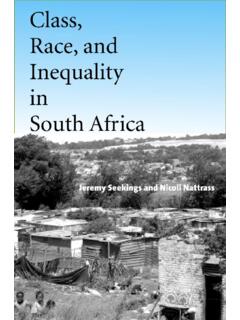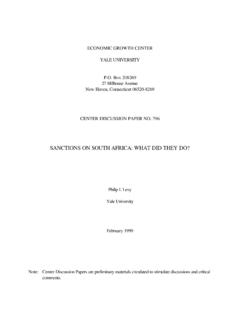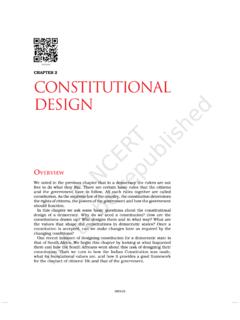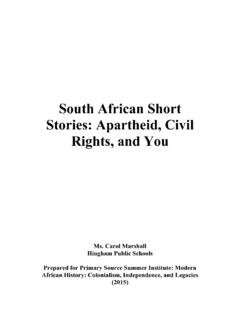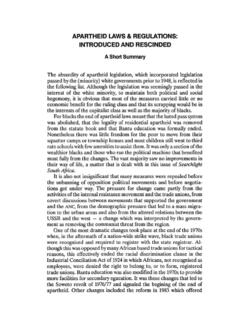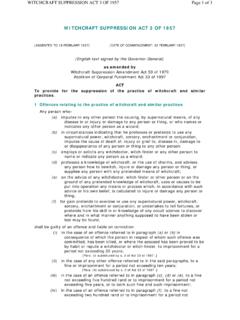Transcription of Townships in the South African Geographic Landscape ...
1 Tel: +27 (0)12 315 5075 Email: 14th Floor, 240 Vermeulen Street, Pretoria, South Africa (Private Bag X115, Pretoria, South Africa, 0001) Townships in the South African Geographic Landscape Physical and Social Legacies and Challenges October 2007 Li Pernegger Susanna Godehart 1 Townships in the South African Geographic Landscape Physical and Social Legacies and Challenges Welcome Introduction The Training for Township Renewal Initiative (TTRI) is the first initiative of its kind. It targets township development practitioners and tries to raise the profile of township development.
2 It also aims to highlight the typical pertinent issues that practitioners will encounter and help us all to fast track some of the regeneration projects. This is not a To Do list and we are optimistic that this five-day session will inform you, educate you, and amuse you. The TTRI is a joint initiative of the National Treasury s NDP Unit, DPLG (in particular the URP team), the South African Cities Network, the DBSA (SCI and Vulindlela), FinMark Trust and Urban LandMark to broaden and deepen the pool of skills for township regeneration. These institutions are all involved in renewal or research programmes in Townships .
3 This course is the first output of this cooperation with the main aim to understand core objectives of township integration, restructuring and the range of development strategies and interventions that can be employed. Part of why we are here is to challenge our perceptions (video clip). This is a start and this five-day session will also identify issues for further research and debate. Li Pernegger is the head of the newly established Neighbourhood Development Programme (NDP) Unit of the National Treasury. It administers the Neighbourhood Development Partnership Grant (NDPG) which aims to: support neighbourhood development projects that provide community infrastructure and create the platform for private sector development and that improve the quality of life of residents in targeted areas.
4 1 Areas targeted by the NDP are Townships . The term township has no formal definition but is commonly understood to refer to the underdeveloped, usually (but not only) urban, residential areas that during apartheid were reserved for non-whites (Africans, Coloureds and Indians) who lived near or worked in areas that were designated white only (under the Black Communities Development Act (Section 33) and Proclamation R293 of 1962, Proclamation R154 of 1983 and GN R1886 of 1990 in Trust Areas, National Home lands and Independent States). Although formal segregation ended with the new democracy, many of these township areas as well as other low-income housing areas (such as informal settlements and low-income housing estates) have seen rapid growth.
5 1 Conditional Grant Framework for the NDPG as published in the Government Gazette, No. 29797, 14 April 2007, Local Government Frameworks and Allocations, 2007/2008, in terms of the Division of Revenue Act (DoRA), Act No. 1 of 2007 , (Schedule 3: Frameworks for Conditional Grants to Municipalities, pg. 108) 2 Consequently NDPG target areas include the following: Townships that were originally created as separate areas for black people, generally located on the periphery of towns and cities Low-income housing estates, which are generally not fully functional neighbourhoods Informal settlements All these areas are characterized by low levels of community facilities and commercial investment, high unemployment, low household incomes and poverty.
6 The term township used in the discussions is deemed to include any of these target areas. The biggest challenge the NDP Unit faces is to encourage municipalities to be much more direct in planning for future-oriented development of Townships , whilst still dealing with backlog issues in these areas. Today s infrastructure requirements are tomorrow s backlogs. The five themes of this TTRI session will be briefly introduced. We acknowledge that our understanding of the issues is not always going to be correct. It is quite ironic that not more presenters in this course have first hand experience of living in Townships .
7 We encourage all participants especially those with first hand experience - to challenge and correct what is being presented, and to contribute their knowledge and ideas in the daily exercises. All of us have a lot to learn. The Challenge We all know that development is uneven . Slide 1: The world is flat Technological innovation has shrunk the world, reducing the cost of transmitting information to virtually nothing. Internet users in developing countries could constitute more than half the world total within five years if current trends persist. The metaphor, popularized by Tom Friedman, is that the world is now flat.
8 But population and economic activity are not uniformly distributed across the globe. Source: London School of Economics 3 If one considers the number of internet users as the London School of Economics has as a global benchmark of progress then South Africa may be doing very well relative to other African countries. However, all of us are here today as the situation in Townships certainly would not indicate that the world is now flat . There are extreme discrepancies across the globe, across Africa, across South Africa between north and South between first world and third world between cities and towns between Townships and urban centres.
9 We experience these differences every day in every city, town and rural area across the country. Townships and informal settlements are being left behind and it is more than time to do something about it. The enormous scale of the challenge will be highlighted. According to FinMark Trust (2004) more than 40% of the urban population lives in Townships alone. Additionally more than 20% of the population lives in informal settlements and low-income housing estates, for example, 73% of residents of Johannesburg live in these areas combined; 43% of residents of Johannesburg live in Soweto alone.
10 Emerging data indicates that Townships are largely but not exclusively an urban challenge. A quarter ( or about million) of South Africa s population of million people live in the 76 largest Townships in the country2. Townships are also likely to be home to the highest concentrations of poverty, too: Slide 2: Population and People in Poverty in Selected Cities The slide shows the number of people in poverty in selected municipalities. They are defined as people living in households with monthly incomes under certain thresholds depending on the size of the household. For 2005 the thresholds varied between R893 for a 1-person household and R3314 for an 8-person household.










